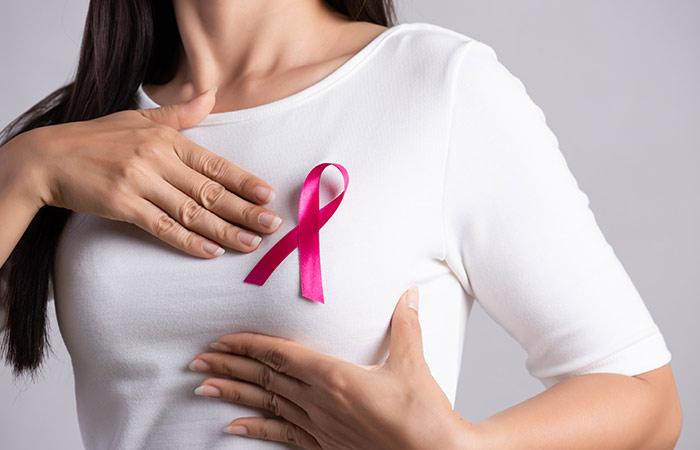While the big ‘C’ word may scare you, it is extremely crucial that you understand and remain updated about the various factors that cause cancer. You might believe you’re safe, as the risk of developing breast cancer before your forties is a mere 5 percent.
However, the truth of the matter is that cancer can strike at any age, and every woman should be well aware of her own cancer risk factors.
Risk factors are certain conditions or behaviors that put a person at risk of developing diseases. With cancer, there are many risk factors involved; some that can be prevented and some that cannot. In this article, we’ll talk about the causes, symptoms, and treatment for breast cancer as well as some international breast cancer statistics (1) (2).
Risk Factors And Prevention
There are many risk factors that are associated with cancer including a person’s age. If cancer runs in your family, you’re at a higher risk of developing it.
Acclaimed actress Angelina Jolie recently made headlines after she took her health into her own hands when she discovered that she suffered from the faulty BRCA1 gene. The disease had claimed the lives of her grandmother, mother, and aunt. She decided to undergo a double mastectomy as well as get her ovaries removed in hopes of lowering her chances of developing breast or ovarian cancer (3).
Here are some of the risk factors that are associated with developing breast cancer (4).
- Aging
- Genetic predisposition
- Reproductive history
- Drinking excessive amounts of alcohol
- Being overweight
- Being a carrier of the faulty BRCA1 or BRCA2 gene
- History of radiation therapy to the chest
- Ashkenazi Jewish ancestry
- Smoking
- Having your first pregnancy after 30 or not having a child at all
- Menstruating before the age of 11
While this may seem like an extensive list of factors, there are plenty of tests and assessments you can undertake to protect you from developing breast cancer.
It should also be noted that the diagnosis of breast cancer in women under the age of 40 is challenging. This is because the breast tissues in younger women are generally denser than those in older women which have lower denseness and elasticity. Due to the breast tissue being denser, a tumor will not show up easily on a mammogram.
Women under 40 are more likely to develop an aggressive form of cancer called metastatic breast cancer. This means that the cancer has advanced to stage 4 and has moved past breast tissue and into other areas of the body, such as the bones or the brain. The survival rate for this form of cancer is way lower than if it had metastasized in other parts of the body. This type of cancer can also be extremely resistant to treatment (5).
As young women don’t expect to be diagnosed with breast cancer, they may ignore signs like lumps or unusual discharge. Although, if one has a family history of breast cancer and is above the age of 25, one can get screened for BRCA mutations. Women can also take extra care by maintaining a healthy weight and exercise regimen, limiting alcohol consumption, and following a healthy diet. If breast cancer is detected and treated in the early stages, chances of recovery and survival are incredibly high at 90 percent (6).
Symptoms Of Breast Cancer
As we discussed, breast cancer can be treated if it is detected at an early stage. Some women may experience just one or more symptoms, but it is absolutely necessary to get tested even if you notice one of these symptoms. These are the symptoms of breast cancer (7):
- New lump in the breast or underarm (armpit)
- Swelling in the breast
- Dimpling of skin on the breast
- Flaky skin on nipple or breast
- Painful feeling in the nipple area or pulling in of nipple
- Bloody or unusual discharge from the nipple
- Any kind of change in the texture or shape of the breast
- Pain in the area of breasts
Breast Cancer Statistics
- Every year more than 1000 women under the age of 40 die due to breast cancer.
- Nearly 80 percent of young women diagnosed with breast cancer find an abnormality themselves.
- Breast cancer is the second most common cancer faced by both women and men.
- Breast cancer is the most common form of cancer faced by pregnant women and young mothers, occurring once in every 3000 pregnancies.
- Since the year 2008, the amount of cases of breast cancer has increased by a whopping 20 percent, and the mortality rate increased by 14 percent.
- More than 800 women younger than 40 are diagnosed with cancer each year.
However, not all the news is negative. In a case study conducted between 1988 and 2011 involving 20,000 women diagnosed with stage 4, breast cancer suggests that the survival rate has increased by tenfold (8).
While breast cancer is still uncommon in your 20s and 30s if you do notice any changes, it is imperative that you receive treatment at the earliest stage possible.
Taking into account your personal family history, dietary habits, weight, etc. can help figure out your early risk factors. Stay healthy, stay aware, and stay safe!
The post Breast Cancer In Your 20s And 30s: Statistics And More appeared first on STYLECRAZE.
from STYLECRAZE https://ift.tt/2NrCBYg
via IFTTT




No comments:
Post a Comment